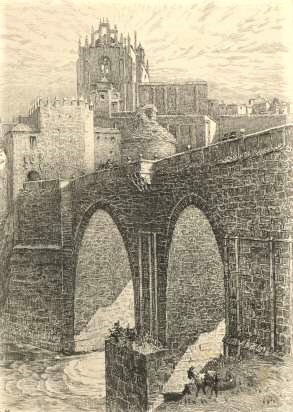
Grove Koger
Today’s selection from my book When the Going Was Good deals with the best-known book by English writer George Borrow, who was born July 5, 1803.
□□□
The Bible in Spain; or, The Journeys, Adventures, and Imprisonments of an Englishman, in an Attempt to Circulate the Scriptures in the Peninsula (London: John Murray, 1843)
The Byronic George Borrow, so famous during his lifetime, so thoroughly forgotten today, is surely ripe for rediscovery. A student of Roma (gypsy) life and lore, he cast himself as a scholar adventurer, providing enthusiastic readers with fictionalized accounts of his early years and travels with the Roma in Lavengro (1851) and The Romany Rye (1857).

Borrow was an apostle of the open road, and made a marathon walk of 27.5 hours in 1833 from his home in Norwich to London, where he applied for a position with the British and Foreign Bible Society. Posted first to Russia, he was next sent to Portugal and Spain (for Borrow “the land of old renown”) to print and distribute copies of the New Testament, a work then proscribed by the Catholic Church. Borrow arrived in Lisbon, Portugal, in late 1835, revisiting London in 1836 and 1838 but otherwise remaining in the Iberian Peninsula and nearby Morocco until 1839, when official Spanish opposition drove him home.
Borrow based The Bible in Spain to a large extent on his letters to the Bible Society. While it reads like a breathless catalogue of picaresque adventures—brawls and narrow escapes abound—the book seems on the whole to be a truthful document. The Iberian Peninsula was then in the throes of the political turmoil precipitated by the Napoleonic wars, and Borrow supplies some suitably grotesque anecdotes of military savagery. Not surprisingly he is also virulently anti-Catholic. As to his ostensible mission, Borrow admits to accomplishing “but very little,” yet pronounces the period “the most happy years of my life.”

If you’re looking for a good edition of The Bible in Spain, the Macdonald edition (London, 1959) includes notes by Peter Quennell. The Everyman’s Library edition (London: Dent; New York: Dutton, 1961) includes an introduction by Walter Starkie, a fellow student of the Roma. The Century edition (London, 1985) includes an introduction by Ted Walker.
Borrow’s other works include The Zincali; or, An Account of the Gypsies of Spain, with an Original Collection of Their Songs and Poetry, and a Copious Dictionary of Their Language (1841); and Wild Wales: Its People, Language, and Scenery (1862).
And if you’d like to know more Borrow, see Michael Collie, George Borrow, Eccentric (Cambridge: Cambridge University Press, 1982); Robert R. Meyers, George Borrow (New York: Twayne, 1966); and David Williams, A World of His Own: The Double Life of George Borrow (Oxford: Oxford University Press, 1982).
□□□
The image at the top of today’s post is a scene of Segovia from the 1843 Murray edition, engraved by Georges-Henri Manesse after a sketch by A. H. Hallam Murray. The portrait of Borrow is by an unidentified artist and is reproduced from the 1920 Dent edition of The Life of George Borrow by Clement K. Shorter, while the bottom image is a view of Toledo engraved by Manesse after a sketch by an unknown artist.
□□□
If you’ve enjoyed today’s post, please share!
